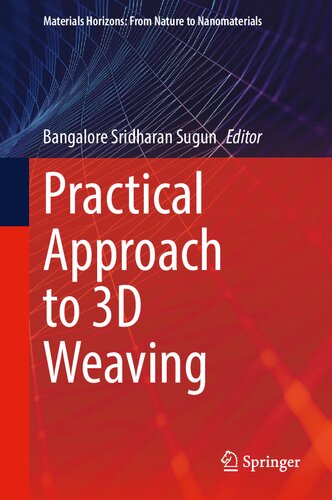

Most ebook files are in PDF format, so you can easily read them using various software such as Foxit Reader or directly on the Google Chrome browser.
Some ebook files are released by publishers in other formats such as .awz, .mobi, .epub, .fb2, etc. You may need to install specific software to read these formats on mobile/PC, such as Calibre.
Please read the tutorial at this link. https://ebooknice.com/page/post?id=faq
We offer FREE conversion to the popular formats you request; however, this may take some time. Therefore, right after payment, please email us, and we will try to provide the service as quickly as possible.
For some exceptional file formats or broken links (if any), please refrain from opening any disputes. Instead, email us first, and we will try to assist within a maximum of 6 hours.
EbookNice Team

Status:
Available4.5
10 reviewsThree Dimensional Weaving is a nascent technology which has triggered research interests around the world. The technology has the potential to finely balance the in-plane and out-of plane properties in composites. This state-of-the-art book focuses on three emerging 3D weaving technologies viz., Orthogonal weaving, Angle interlock weaving and Dual Plane shedding based 3D weaving. It provides focused knowledge about these technologies and has a pragmatic approach to developing customized 3D weaving machines. Fundamental approach to understanding weave design basics, thereupon practical weaving , addressing quality aspects, arriving at testing approaches are all detailed in the book. The applications for these technologies are both in strategic (space, aerospace, defense) as well as societal (medical, automobile) sectors.
The book has six chapters, wherein the first three chapters are devoted to Orthogonal and angle interlock weaving and their quality control aspects. Approach to weaving preforms of complex geometries such as T-stiffeners, tapers, Origami-based structures are also discussed The fourth and fifth chapter are entirely devoted to machinery development for Dual plane shedding based 3D weaving often termed as ‘True 3D weaving’. The chapters discuss detailed machine design of the sub-elements such as let-off, shedding, picking, beat-up and take-up. The reader is taken through a prototype development of a 3D weaving machine by way of concept, illustrations, practical development and weaving of samples. The sixth chapter summarises the editor’s views about the technology. This volume will be beneficial to scientists and researchers in both academia and the industry.